
Sir George Cayley Bt. (1773 - 1857)
Sir George Cayley, born in 1773, is sometimes called the 'Father of Aviation'. A pioneer in his field, he is credited with the first major breakthrough in heavier-than-air flight. Cayley literally has two great spurts of aeronautical creativity, separated by years during which he did little with the subject. He was the first to identify the four aerodynamic forces of flightùweight, lift, drag, and thrustùand their relationship and also the first to build a successful human-carrying glider.
In his experiments, Cayley would first test his ideas with small models and then gradually progress to full-scale demonstrations. He also kept meticulous records of his observations. One of his first experiments as a young man was to build a small helicopter model. This toy was rooted deep in European history. The earliest ancestors of the device date to the 14th century. Cayley was inspired by a version developed in 1784 by the Frenchmen Launoy and Bienvenu. It had two rotors consisting of feathers stuck in corks and was driven by a string from a bow. The design demonstrated an understanding of how a propeller worked. It also addressed CayleyÆs interest in finding a means of powering an aircraft. He attempted to use an engine fueled by gunpowder but it was unreliable. His inability to find a means of propulsion caused him to revert temporarily to Leonardo da VinciÆs concept of using flapping wings as a means of propulsion. This resulted in his 1843 convertiplane model called the ôAerial Carriage.ö Cayley reverted to ornithoptering propulsion and vertical flight ideas on several occasions in his career. In 1799, Cayley designed a configuration that was basically in the form of a modern airplane with a fuselage and wings. Etched on a silver disk this design bears a close relationship to the modern flying machines of more than a century later. On one side of the disc he showed the forces that govern flight. On the reverse side, he engraved an aircraft that illustrated how those forces operated. It had a fixed main wing, a fuselage, a cruciform tail unit with surfaces for vertical and horizontal control, a cockpit for the pilot, and a rudimentary means of propulsion that consisted of revolving vanes, a precursor to the propeller. Thus, one hundred years before the Wright brothers flew their glider, Cayley had established the basic principles and configuration of the modern airplane, complete with fixed wings, fuselage, and a tail unit with elevators and rudder, and had constructed a series of models to demonstrate his ideas. Experiments that he began to carry out in 1804 allowed him to learn more about aerodynamics and wing structures using a whirling arm device. He observed that birds soared long distances by simply twisting their arched wing surfaces and deduced that fixed-wing machines would fly if the wings were cambered. This was the first scientific testing of airfoilsùthe part of the aircraft that is designed to produce lift. After these experiments, he constructed what is considered to be the first real airplane in history. This glider, which was basically a kite on top of pole, was about 5 feet (1.5 meters) long, with a fixed wing set at an angle of incidence of 6 degrees and a cruciform tail that was attached to the fuselage by universal joints. Movable ballast controlled the center of gravity. After this model successfully flew, Cayley designed a larger model glider with rigid wings. By 1808, Cayley had constructed a glider with a wing area of almost 300 square feet (28 square meters). By the middle of 1809, Cayley had investigated the improved lifting capacities of cambered wings, the movement of the center of pressure, longitudinal stability, and the concept of streamlining. He demonstrated the use of inclined, rigid wings to provide lift and roll stability, and the use of a rudder steering control. He even came to realize that an area of low pressure is formed above the wing. By 1809, he had advanced from model gliders to the building and successful flying of a glider with a total wing area of approximately 172 square feet (18.5 square meters). Soon after, Cayley published a paper, On Aerial Navigation (1809-1810), which appeared in NicholsonÆs Journal of Natural Philosophy, Chemistry and the Arts. In this paper, he laid out the basis for the study of aerodynamics. However, this work was not known and acknowledged for some years. After having built several models (with an interruption to explore the possibility of an Aerial Carriage of 1843), Cayley concentrated on experiments with full-size gliders. He built his first full-size glider in 1849 and initially carried out trials with ballast. Later that year, the ten-year-old son of one his servants became the first person in history to fly when he made a short flight in a Cayley glider. Four years later, in 1853 and fifty years before the first powered flight was made at Kitty Hawk, North Carolina, Cayley built a triplane glider (a glider with three horizontal wing structures) that carried his coachman 900 feet (275 meters) across Brompton Dale in the north of England before crashing. It was the first recorded flight by an adult in an aircraft. Throughout his long career, Cayley recognized and searched for solutions to the basic problems of flight. These included the ratio of lift to wing area, determination of the center of wing pressure, the importance of streamlined shapes, the recognition that a tail assembly was essential to stability and control, the concept of a braced biplane structure for strength, the concept of a wheeled undercarriage, and the need for a lightweight source of power. Cayley correctly predicted that sustained flight would not occur until a lightweight engine was developed to provide adequate thrust and lift, an event that did not take place until the flight of Orville and Wilbur Wright in 1903.
1799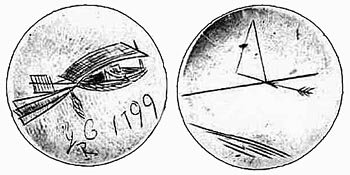 George Cayley, aeroplane design, 1799 engraving It had fixed wings for lift, a movable tail for control, and rows of "flappers" beneath the wings for thrust
In 1799, Sir George Cayley, a baronet in Yorkshire, near Scarborough, England, conceives a craft with stationary wings to provide lift and "flappers" to provide thrust. It also has a movable tail to provide control. So convinced is he that this idea is an earth-shaker, he engraves a drawing of this craft on a silver disk. Cayley is the first to separate the different forces that keep an aircraft in the air, and his engraving is the first recorded drawing of a fixed-wing aircraft -- an airplane.
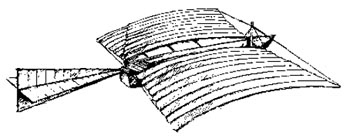 George Cayley, aeroplane design, 1799, perspective sketch It had fixed wings for lift, a movable tail for control, and rows of "flappers" beneath the wings for thrust
1804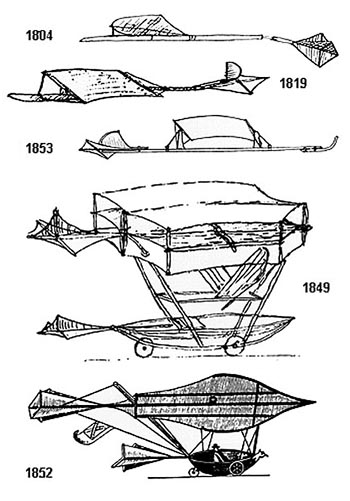 George Cayley, Gliders, 1804 -1852
Airfoil Experiments, 1804Sir George Cayleyhttp://firstflight.open.ac.uk/ Cayley was interested in reducing the 'direct resistance' (drag) of the spars in his gliders and developed the first instrument for testing streamlining. He cut the flat section of the spar to half the frontal area of the wider, curved part, to test the theory of the time that they would have the same drag.
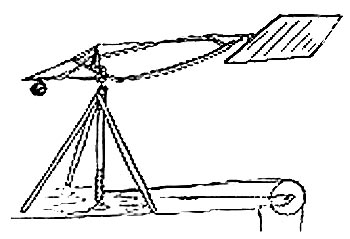 George Cayley, aerofoil testing device 'whirling arm' http://firstflight.open.ac.uk/
On the End of a Whirling Arm http://www.hq.nasa.gov Sir George Cayley (1773-1857) also used a whirling arm to measure the drag and lift of various airfoils. His whirling arm was 5 feet long and attained tip speeds between 10 and 20 feet per second.
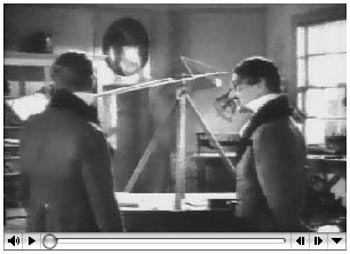 George Cayley, aerofoil testing device 'whirling arm' - Movie Click the above image to download the Quicktime movie [2.9Mb]
Armed with test data from the arm, Cayley built a small glider that is believed to have been the first successful heavier-than-air vehicle in history. In 1804 Cayley built and flew an unmanned glider with a wing area of 200 square feet.
 George Cayley, airfoil design, 1804 Download a 750pixel image
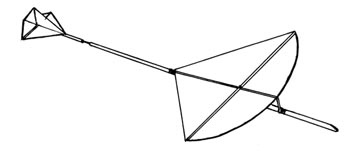 George Cayley, Glider, 1804 Download a 750pixel image
By 1852 he had a triplane glider design that incorporated many features of modern aircraft, but manned, powered aircraft were still half a century away. Although Cayley performed many aerodynamic experiments and designed precocious airplane models, his major contribution to flight was one of design philosophy. Before Cayley, would-be aeronauts believed that the propulsion system should generate both lift and forward motion at the same time, as birds and helicopters do. Cayley said, "Make a surface support a given weight by the application of power to the resistance of air." In other words, use an engine to create forward motion and let the motion develop lift via the wings. This separation of propulsion and lift functions, simple though it sounds, was a revolutionary change in the way people thought about aircraft. One need not build planes with flapping wings! A whole new horizon in aircraft design opened up.
1809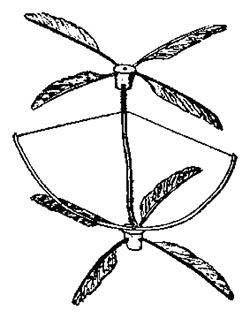 George Cayley, 'Helicopter', 1809 Based on design by Launoy and Bienvenu 1784. See Cayley's, 3 part essay On Aerial Navigation, Nicholson's Journal of Natural Philosophy, 1809, 1810
Progress in Flying Machines Octave Chanute, Screws to Lift and Propel : Part I March 1892 http://invention.psychology.msstate.edu In describing the various proposals and experiments which have been made to compass artificial flight by means of rotating screws, the latter will chiefly be considered as instruments from which to obtain support of a given weight in the air. There is no question that they can serve as propellers if the support be otherwise obtained, nor that if a screw can lift and sustain its own prime motor, it can also be made to progress horizontally, either by inclining it at the proper angle or by adding a vertical screw. ... The first practical experiment known, however, is that of M. Launoy, a naturalist, and M. Bienvenu, a mechanician, who jointly exhibited before the French Academy of Sciences in 1784 the little apparatus shown below.
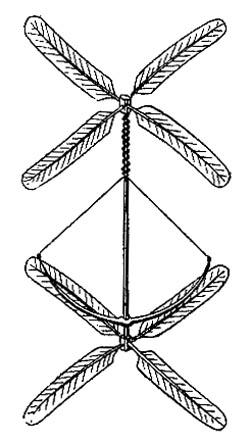 Launoy and Bienvenu 'Helicopter', 1774 http://invention.psychology.msstate.edu
It consisted of two superposed screws, about one foot in diameter, each composed of four feathers inserted in sockets at the ends of a rotating axle. This axle was put into motion by the unwinding of a cord fastened to the two extremities of a bow and the report to the French Academy (May 1, 1784) says:
"The working of this machine is very simple. When the bow has been bent by winding the cord, and the axle placed in the desired direction of hight-say vertically, for instance- the machine is released. The unbending bow rotates rapidly, the upper wings one way and the lowerwings the other way, these wings being arranged so that the horizontal percussions of the air neutralize each other, and the vertical percussions combine to raise the machine. It therefore rises and falls back afterward from its own weight."Launoy & Bienvenu proposed also to build a large machine, and to go up in it themselves. It is not stated whether this was ever attempted but probably not, as a brief investigation must have satisfied them that they had no adequate primary motive power at hand to lift even its own weight in that way, and that with a secondary or stored power tile machine would fly but for a few seconds. Practically the same device was constructed by Sir George Cayley in 1795, and described by him in Nicholson's Journal for April, 1810; but whether he reinvented it or borrowed the idea from Launoy & Bienvenu is not stated. He mentions it merely as a toy, and his writings seem to indicate that he expected success to be achieved instead with an aeroplane to be driven by some sort of propelling apparatus, if only a sufficiently light first mover could be contrived.
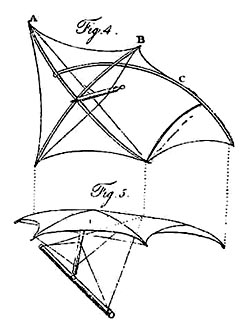 George Cayley, wing experiments, 1809 from Cayley's, 3 part essay On Aerial Navigation published in Nicholson's Journal of Natural Philosophy, 1809, 1910
1816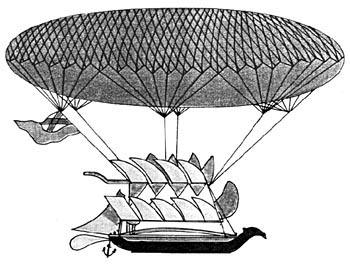 George Cayley, Airship, 1816
1843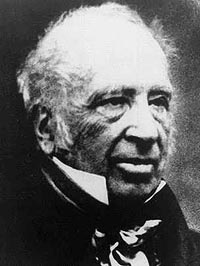 George Cayley in later life, c.1850
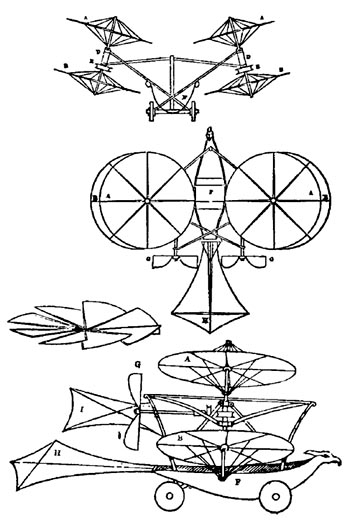 George Cayley, 'Aerial Carriage', 1843 A biplane 'convertiplane' based on (but reportedly not accredited to) an idea by one Robert Taylor for a monoplane 'convertiplane' around the same time Download a 1000pixel image
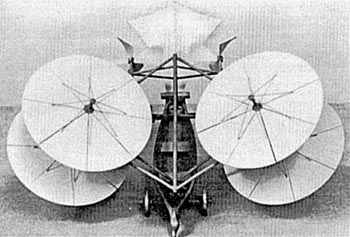 George Cayley, 'Aerial Carriage', 1843 A biplane 'convertiplane' based on (but reportedly not accredited to) an idea by Robert Taylor for a monoplane 'convertiplane' around the same time
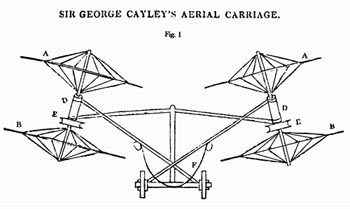 George Cayley, 'Aerial Carriage', 1843 A biplane 'convertiplane' based on (but reportedly not accredited to) an idea by one Robert Taylor for a monoplane 'convertiplane' around the same time Download a 1000pixel image
1849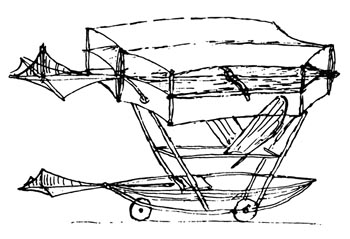 George Cayley, Triplane, 'Boy Carrier' 1849 Download a 1000pixel image
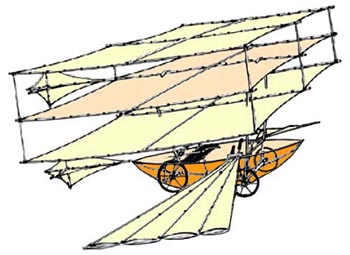 George Cayley, Triplane, 'Boy Carrier' 1849
1852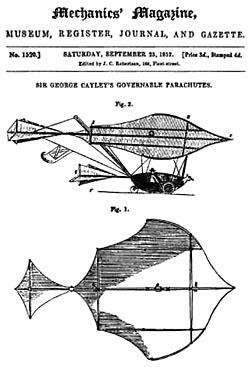 George Cayley, 'Governable Parachute', 'Man Carrier' 1852 Mechanics Magazine, September 25, 1852
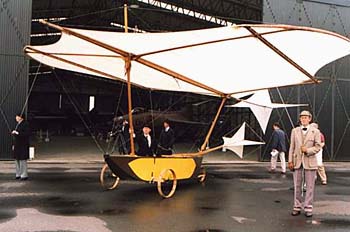 George Cayley, 'Governable Parachute', 'Man Carrier' 1852, Replica
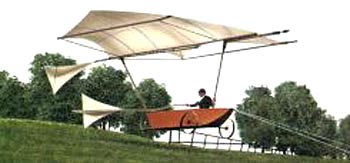 George Cayley, 'Governable Parachute', 1852, Replica in flight
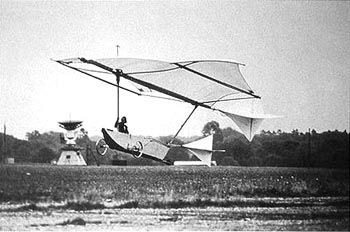 George Cayley, 'Governable Parachute', 1852, Replica in flight
other items...
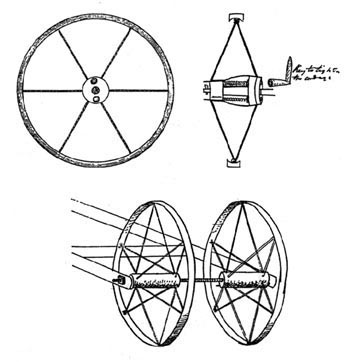 George Cayley, Tensioned Wheels
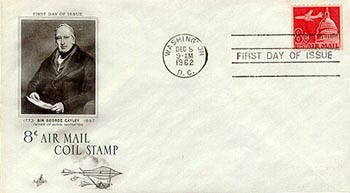 George Cayley, FDC
Sir George Cayley It is generally accepted that the aeroplane is the invention of Sir George Cayley in 1799 at Brompton, near Scarborough in Yorkshire. Indeed, in 1909 Wilbur Wright himself paid Cayley the following tribute:
"About 100 years ago, an Englishman, Sir George Cayley, carried the science of flight to a point which it had never reached before and which it scarcely reached again during the last century."Restricted to gliders for lack of a light weight engine, for his designs of these Cayley employed the common rule, supplemented by results from his own whirling arm experiments which explored the improved lifting effect of increasing wing incidence. Because of his choice of low wing aspect ratio on structural grounds, such gliders achieved lift to drag ratios as low as 3, perhaps as high as 7. Initially, Cayley saw his gliders' cruciform tail units as supplying merely steering and re-trimming (for different flight speeds) but in his later designs -- notably the Governable Parachute of 1852 with its duplicated tail -- there began to emerge an appreciation of the stabilising function of the tail. Cayley introduced many innovations -- wing dihedral, the tension wheel undercarriage are diverse examples -- and, as early as 1809, the suggestion that the shape of the rear of a body is as important as the front in determining resistance so that a streamlined tail is beneficial.
A History of Aeronautics On the fifth of June, 1783, the Montgolfiers' hot-air balloon rose at Versailles, and in its rising divided the study of the conquest of the air into two definite parts, the one being concerned with the propulsion of gas lifted, lighter-than-air vehicles, and the other being crystallised in one sentence by Sir George Cayley:
'The whole problem,' he stated, 'is confined within these limits, viz.: to make a surface support a given weight by the application of power to the resistance of the air.'For about ten years the balloon held the field entirely, being regarded as the only solution of the problem of flight that man could ever compass. So definite for a time was this view on the eastern side of the Channel that for some years practically all the progress that was made in the development of power-driven planes was made in Britain. In 1800 a certain Dr Thomas Young demonstrated that certain curved surfaces suspended by a thread moved into and not away from a horizontal current of air, but the demonstration, which approaches perilously near to perpetual motion if the current be truly horizontal, has never been successfully repeated, so that there is more than a suspicion that Young's air-current was NOT horizontal. Others had made and were making experiments on the resistance offered to the air by flat surfaces, when Cayley came to study and record, earning such a place among the pioneers as to win the title of 'father of British aeronautics.' Cayley was a man in advance of his time, in many ways. Of independent means, he made the grand tour which was considered necessary to the education of every young man of position, and during this excursion he was more engaged in studies of a semi-scientific character than in the pursuits that normally filled such a period. His various writings prove that throughout his life aeronautics was the foremost subject in his mind; the Mechanic's Magazine, Nicholson's Journal, the Philosophical Magazine, and other periodicals of like nature bear witness to Cayley's continued research into the subject of flight. He approached the subject after the manner of the trained scientist, analysing the mechanical properties of air under chemical and physical action. Then he set to work to ascertain the power necessary for aerial flight, and was one of the first to enunciate the fallacy of the hopes of successful flight by means of the steam engine of those days, owing to the fact that it was impossible to obtain a given power with a given weight. Yet his conclusions on this point were not altogether negative, for as early as 1810 he stated that he could construct a balloon which could travel with passengers at 20 miles an hour--he was one of the first to consider the possibilities of applying power to a balloon. Nearly thirty years later--in 1837--he made the first attempt at establishing an aeronautical society, but at that time the power-driven plane was regarded by the great majority as an absurd dream of more or less mad inventors, while ballooning ranked on about the same level as tight-rope walking, being considered an adjunct to fairs and fetes, more a pastime than a study. Up to the time of his death, in 1857, Cayley maintained his study of aeronautical matters, and there is no doubt whatever that his work went far in assisting the solution of the problem of air conquest. His principal published work, a monograph entitled Aerial Navigation, has been republished in the admirable series of 'Aeronautical Classics' issued by the Royal Aeronautical Society. He began this work by pointing out the impossibility of flying by means of attached wings, an impossibility due to the fact that, while the pectoral muscles of a bird account for more than two-thirds of its whole muscular strength, in a man the muscles available for flying, no matter what mechanism might be used, would not exceed one-tenth of his total strength. Cayley did not actually deny the possibility of a man flying by muscular effort, however, but stated that 'the flight of a strong man by great muscular exertion, though a curious and interesting circumstance, inasmuch as it will probably be the means of ascertaining finis power and supplying the basis whereon to improve it, would be of little use.' From this he goes on to the possibility of using a Boulton and Watt steam engine to develop the power necessary for flight, and in this he saw a possibility of practical result. It is worthy of note that in this connection he made mention of the forerunner of the modern internal combustion engine; 'The French,' he said, 'have lately shown the great power produced by igniting inflammable powders in closed vessels, and several years ago an engine was made to work in this country in a similar manner by inflammation of spirit of tar.' In a subsequent paragraph of his monograph he anticipates almost exactly the construction of the Lenoir gas engine, which came into being more than fifty-five years after his monograph was published. Certain experiments detailed in his work were made to ascertain the size of the surface necessary for the support of any given weight. He accepted a truism of to-day in pointing out that in any matters connected with aerial investigation, theory and practice are as widely apart as the poles. Inclined at first to favour the helicopter principle, he finally rejected this in favour of the plane, with which he made numerous experiments. During these, he ascertained the peculiar advantages of curved surfaces, and saw the necessity of providing both vertical and horizontal rudders in order to admit of side steering as well as the control of ascent and descent, and for preserving equilibrium. He may be said to have anticipated the work of Lilienthal and Pilcher, since he constructed and experimented with a fixed surface glider.
'It was beautiful,' he wrote concerning this, 'to see this noble white bird sailing majestically from the top of a hill to any given point of the plain below it with perfect steadiness and safety, according to the set of its rudder, merely by its own weight, descending at an angle of about eight degrees with the horizon.'It is said that he once persuaded his gardener to trust himself in this glider for a flight, but if Cayley himself ventured a flight in it he has left no record of the fact. The following extract from his work, Aerial Navigation, affords an instance of the thoroughness of his investigations, and the concluding paragraph also shows his faith in the ultimate triumph of mankind in the matter of aerial flight:
'The act of flying requires less exertion than from the appearance is supposed. Not having sufficient data to ascertain the exact degree of propelling power exerted by birds in the act of flying, it is uncertain what degree of energy may be required in this respect for vessels of aerial navigation; yet when we consider the many hundreds of miles of continued flight exerted by birds of passage, the idea of its being only a small effort is greatly corroborated.This extract from his work gives but a faint idea of the amount of research for which Cayley was responsible. He had the humility of the true investigator in scientific problems, and so far as can be seen was never guilty of the great fault of so many investigators in this subject--that of making claims which he could not support. He was content to do, and pass after having recorded his part, and although nearly half a century had to pass between the time of his death and the first actual flight by means of power-driven planes, yet he may be said to have contributed very largely to the solution of the problem, and his name will always rank high in the roll of the pioneers of flight.
Further Reading
"Arguably the most important paper in the invention of the airplane is a triple paper On Aerial Navigation by Sir George Cayley. The article appeared in three issues of Nicholson's Journal. In this paper, Cayley argues against the ornithopter model and outlines a fixed-wing aircraft that incorporates a a separate system for propulsion and a tail to assist in the control of the airplane. Both ideas were crucial breakthroughs necessary to break out of the ornithopter tradition."
|
© Copyright 1999-2002 CTIE - All Rights Reserved - Caution |
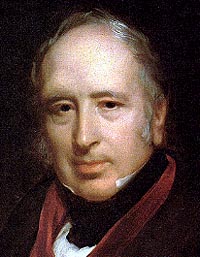 Sir George Cayley
Sir George Cayley